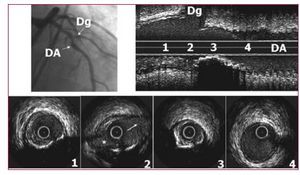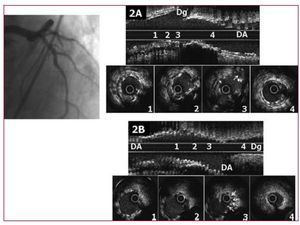A 66-year-old man with hypertension and acute coronary syndrome without ST segment elevation underwent cardiac catheterization. Single-vessel disease was observed at the bifurcation of the left anterior descending artery and diagonal artery (LAD-Dg), which was treated with an 18-mm MultiLink Frontier dedicated stent mounted on a dual balloon system that leaves a metal-free side portal oriented toward the secondary branch. The baseline study (Figure 1) showed a lesion in the LAD-Dg (Medina classification, 0,1,1). Intravascular ultrasound imaging of the main vessel showed the following: 1) proximal segment, eccentric plaque (from 5 to 9 o´clock) and positive remodeling, preserving the lumen area; 2) carina with Dg branch (arrow at 2 o´clock) and a septal branch (asterisk at 8 o´clock); 3) plaque with severe calcification, image indicating negative remodeling, and lumen area <4 mm2; and 4) distal reference, normal trilaminar structure. The outcome following treatment with the 3´18-mm Frontier device is shown in Figure 2. In Figure 2A, the stent is observed in the main vessel, preserving the geometry of the bifurcation, and the metal-free portal is oriented toward the Dg: 1) proximal segment, adequate apposition, with symmetry index >0.85; 2) proximal segment of the carina; 3) portal oriented toward Dg (hyperechogenic guidewire in the interior, arrow at 2 o'clock); 4) distal stent, good apposition and symmetry index. Ultrasound images from the Dg branch (Figure 2B) show the following: 1) stent in the proximal portion; 2 and 3) carina sections show some scaffolding of the Dg ostium (arrows); and 4) distal reference, normal trilaminar structure.
Figure 1.
Figure 2.
At 8 months following the procedure, the patient was asymptomatic and stress testing was negative. These images provide a detailed study of scaffolding of a bifurcation treated with the Frontier dedicated stent system. Nonetheless, until drug-eluting stents with this design become available, treatment of bifurcations will have suboptimal outcome at the mid-term.



